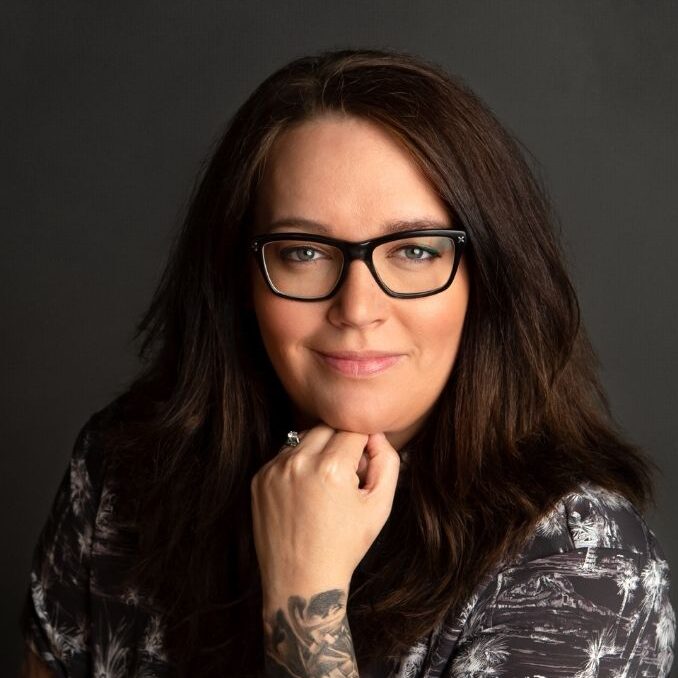By…
Nicole McLaren is scaling her Indigenous-focused subscription box — and helping to grow her suppliers along with it.
A conversation with the founder and CEO of Raven Reads.

When Nicole McLaren began her small workplace book club in a large mining company in Vancouver, her goal was to engage her co-workers in reconciliation — using literature to educate them on the devastating impact residential schools had on Indigenous people in Canada, and the societal issues present today.
Nicole, who is of mixed heritage and Indigenous roots, focused on Indigenous authors to help her co-workers gain understanding. Realizing she wanted to reach more broadly than one company, Nicole developed Raven Reads, an Indigenous literature and giftware subscription box. She launched from her kitchen table in 2017 with just a handful of subscribers — and an aim to inspire, educate, and create a safe space for dialogue.
Today things look quite different. With thousands of subscribers and a much broader reach, her experience growing a side-hustle into a thriving venture has provided her with invaluable advice to share. Nicole has become a coach and mentor to her vast supply chain of Indigenous-owned businesses. She’s even expanding into fulfilment operations.
I sat down with Nicole to learn more about Raven Reads and her on-going mission to support and elevate the Indigenous economy by staying true to her values and working closely with her extensive supply chain and investors.
I know it’s not easy to turn a passion project into a successful business venture. Can you tell me about the early days of Raven Reads and how you got your start?
Coming into the subscription box world, I felt a bit late to the game. Most of the heavy hitters got their start around 2006 and 2007, but there was nothing with a focus on Indigenous books or giftware. I had a four-hour commute by bus and train at the time, so I jacked up my data and spent all of that time researching subscription boxes and writing a business plan.
I subscribed to other boxes and analyzed everything — the quality of the box, the thickness of the cardboard, the number of items, and the way they were shipped. I then sought help from Small Business BC to wrap up my financial projections, and they helped me access start-up funds through a local Aboriginal financial institution, Futurpreneur Canada, and BDC.
I did a soft launch in September 2017, and on Cyber Monday I was interviewed by CBC Radio’s Unreserved. We went from 20 subscribers to 200 overnight.
At that time it was still a very focused idea — a subscription box with one book and two gifts per season — and now you’re doing work to coach, support, and promote your own supply chain of Indigenous-owned businesses. Did the business evolve in that direction organically?
Raven Reads started as the quintessential reconciliation toolkit and it has evolved into a platform for amplifying Indigenous authors and entrepreneurs — and that shift was organic.
I was always aware of the risk that I would hit a bit of a wall in terms of suppliers’ manufacturing capabilities. There was certainly no shortage of suppliers out there, and many were getting more creative with their offerings, but about two years ago I started to think about integrating more vertically throughout the supply chain. It was a risk management approach. What we’ve been examining over the past year and a half is how do we build out a more integrated system that supports suppliers and supports us to grow and diversify.
In terms of coaching, we help our suppliers with best practices for growth, wholesale, shipping and packaging, among other things. Some of our suppliers have become close friends and we try to offer suggestions on product ideas as well. One example, SheNative, is a leather goods designer and manufacturer from Saskatoon and we’ve actually been working with her on a custom product that will be exclusive to Raven Reads. I’m always looking for collaborative opportunities like this.
“From the consumer perspective, we certainly offer a convenient path to accessing authentic products. I know over the past year there’s been a heightened sense of fact checking where products come from and who is actually behind them.”
I imagine consumers use your subscription box as a way to learn more about Indigenous-owned businesses and products. Are you able to track consumer behaviour to see if the box drives sales for your suppliers?
We are in the process of looking at how we can track the feedback loop. This month we’ll be including a unique discount code for each of our suppliers in the box. So, if you like something in this month’s box, you can use the code to buy more goods from their website, and we’ll be able to start tracking sales in a more quantitative way. We do know that we are helping to raise awareness of Indigenous brands and authors.
From the consumer perspective, we certainly offer a convenient path to accessing authentic products. I know over the past year there’s been a heightened sense of fact checking where products come from and who is actually behind them. We offer that transparency, so our subscribers know they can trust the products we include to be authentic.
Many organizations are launching supplier diversity programs as part of their commitment to diversity, equity and inclusion. Do you see these programs making an impact?
Certainly, I can see these programs making an impact — but in my observations of working with other Indigenous women primarily across Canada, I see a bit of a gap between supply and demand when it comes to supplier diversity programs.
There are a lot of suppliers keen to participate, but there’s a lag in terms of guiding and supporting them to be manufacturing products that are likely to be in demand by a lot of these programs. And, if they do have a product that’s likely to fall into scope, they may not have manufacturing capability or capital to produce in volumes needed to take on the quantity required to make the purchase orders.
What do you see as the solution for this?
What’s needed is more funding. There’s a lot of funding to get people started, but I see a lot of colleagues and suppliers who are in a holding pattern. They can’t take advantage of these massive scaling opportunities because of the lack of capital to get the necessary equipment to do that, or because supply chain disruption is hindering their ability to get packaging or raw materials. So they’re getting approached by buyers for various things and having to turn them down.
I know you accessed funding early on, including some from BDC, to launch Raven Reads. Have you faced challenges getting funding beyond that?
It’s much easier to find start-up funds, in my opinion. When you’re in the growth stage, you have to make some big decisions around what you need the funding for and what type of funding would be best for that type of need.
For me, looking at dilutive options has been a big learning curve — it’s something I don’t know much about. In my experience, equity investment is still fairly new to Indigenous women small business owners. The idea of giving up a piece of something you own can be quite intimidating. The more you see out there, the easier it will be and it will become a little less scary. It’s an investment of time to put yourself out there and learn in order to find out how it works.
“As an impact driven brand, I’m looking for impact-driven investors, partners who are aligned with our values.”
I understand you’re currently looking to raise another round of funding. What’s next for Raven Reads in terms of plans for growth?
We are currently looking at how to scale Raven Reads. We have operational demands and we need to innovate and improve in order to meet those. The pandemic did finally force us out of my basement last October, and we moved into a warehouse — which we’ve already outgrown.
We have an ambitious growth plan for Raven Reads to take up a bigger space in the North American subscription e-commerce market. In the same breath, we are also looking to launch a fully-integrated logistics network for Indigenous and other underrepresented brands from Western Canada, which will include a 100,000 square foot warehouse, contract manufacturing, and logistics venture here in BC. So, we definitely have big capital needs.
What I’m doing is simultaneously raising funds for both. What we want to be able to do is support the logistics and fulfilment needs of Raven Reads as well as our suppliers, while also offering the component of contract manufacturing that would allow clients to outsource their product production to an Indigenous-owned, women-owned business. This would make it possible for them to produce higher volumes and therefore be able to capitalize on purchase orders from major retailers.
As an impact driven brand, I’m looking for impact-driven investors, partners who are aligned with our values.
Through your business you’ve become a mentor to many other Indigenous women entrepreneurs. What advice do you typically share when coaching them?
I feel like Indigenous women entrepreneurs, whether it’s cultural or the way we are raised, tend to be shy about articulating our most ambitious goals. There’s a hesitancy to say, ‘I want to build a multi-million-dollar business’ and talking about exits can also feel awkward. So, I encourage them to be more transparent, to plan for growth, and to come to terms with being ambitious business owners. I also find many of us chase broad product offerings, and my advice would be to not spread yourself too thin in terms of the diversity of your offering — to instead focus on establishing a core product offering and doing that really well.
Speaking of core product offering, has your commitment to featuring books as the main component of a Raven Reads box wavered over time? Also, I’m curious, how do you go about choosing books and authors to feature?
The book is still the foundation of Raven Reads, because that’s where the concrete learning and awareness building happens. When I launched the box, it was on the heels of the release of the Truth and Reconciliation Commission Reports, and the call to action was immediate. We went with Seven Fallen Feathers by Tanya Talaga as our first book because it was a critical book to kick things off. We have not done a lot of non-fiction since. We always look for books that have been released in the last 90 days to help eliminate the risk that they’ve already been purchased, and we try to stay ahead of what’s coming up from Canadian and American Indigenous authors.
For those beginning their Indigenous literature journey, what are the top five books you’d recommend people start with?
My bookshelf is filled with books I’d recommend, but these five are especially poignant. In Search of April Raintree by Beatrice Mosionier, Indian Horse by Richard Wagamese, Birdie by Tracey Lindberg, The Break by Katherena Vermette. And, of course, Seven Fallen Feathers, which I always recommend as a good place to start.
Eva…
Meet Eva Hartling, Founder of The Brand is Female: Empowering Women and Celebrated for Her Impact on Women in Leadership
By…
Sponsorship, Strategy, and Success: How this Scotiabank Executive Champions Career Advancement Through Advocacy
By…
Courage, Culture, and Change: How This Scotiabank Executive Advocates for Indigenous Empowerment
By…
How a Rural Upbringing Shaped This Scotiabank Leader’s Commitment to DEI
By…

